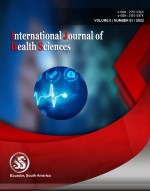Evaluation of stability of temporary anchorage devices for orthodontic treatment
A clinical study
Keywords:
Anchorage procedures, anchorage techniques, orthodontic anchorage procedures, miniscrews, tem¬porary anchorage deviceAbstract
Aim: The purpose of the present research was to assess the stability of temporary anchorage devices used in orthodontic treatment. Methodology: Freshly ovine mandibles were cut in blocks. Twenty-seven miniscrews (diameter 1.6 × 8 mm; G2, Dual Top Anchor System, Jeil Medical, Seoul, Korea) were inserted in the blocks and divided in 2 experimental groups: single miniscrew and the innovated design “Seifi Twin Screw (STS)”. Primary stability was evaluated by Periotest “M”® device. Results: Independent t-test showed a significant difference between 2 experimental groups in periotest evaluation (p< 0.05). STS demonstrated higher primary stability due to its mechanical configuration and design. Conclusion: The STS provides higher primary stability and was found to be effective in increased success rate of miniscrew systems from the standpoint of primary stability.
Downloads
References
Kim YH, Yang SM, Kim S, Lee JY, Kim KE, Gianelly AA, et al. Midpalatal miniscrews for orthodontic anchorage: factors affecting clinical success. Am J Orthod Dentofacial Orthop. 2010;137:66-72.
Kuroda S, Sugawara Y, Deguchi T, Kyung HM, Takano-Yamamoto T. Clinical use of miniscrew implants as orthodontic anchorage: suc¬cess rates and postoperative discomfort. Am J Orthod Dentofacial Or¬thop. 2007;131:9-15.
Crismani AG, Bertl MH, Celar AG, Bantleon HP, Burstone CJ. Mi¬niscrews in orthodontic treatment: review and analysis of published clinical trials. Am J Orthod Dentofacial Orthop. 2010;137:108-13.
Nienkemper M, Wilmes B, Panayotidis A, Pauls A, Golubovic V, Schwarz F, et al. Measurement of mini-implant stability using resonan¬ce frequency analysis. Angle Orthod. 2013;83:230-8.
Son S, Motoyoshi M, Uchida Y, Shimizu N. Comparative study of the primary stability of self-drilling and self-tapping orthodontic mi¬niscrews. Am J Orthod Dentofacial Orthop. 2014;145:480-5.
Oh JS, Kim SG. Clinical study of the relationship between implant stability measurements using Periotest and Osstell mentor and bone quality assessment. Oral Surg Oral Med Oral Pathol Oral Radiol. 2012;113:e35-40.
Youn JW, Cha JY, Yu HS, Hwang CJ. Biologic evaluation of a ho¬llow-type miniscrew implant: an experimental study in beagles. Am J Orthod Dentofacial Orthop. 2014;145:626-37.
Park HS, Jeong SH, Kwon OW. Factors affecting the clinical suc¬cess of screw implants used as orthodontic anchorage. Am J Orthod Dentofacial Orthop. 2006;130:18-25.
Marquezan M, Osório A, Sant’Anna E, Souza MM, Maia L. Does bone mineral density influence the primary stability of dental implants? A systematic review. Clin Oral Implants Res. 2012;23:767-74.
Migliorati M, Benedicenti S, Signori A, Drago S, Barberis F, Tour¬nier H, et al. Miniscrew design and bone characteristics: an experi¬mental study of primary stability. Am J Orthod Dentofacial Orthop. 2012;142:228-34.
Samrit V, Kharbanda OP, Duggal R, Seith A, Malhotra V. Bone density and miniscrew stability in orthodontic patients. Aust Orthod J. 2012;28:204-12.
Marquezan M, Mattos CT, Sant’Anna EF, de Souza MM, Maia LC. Does cortical thickness influence the primary stability of miniscrews?: A systematic review and meta-analysis. Angle Orthod. 2014;84:1093-103.
Maria O, Ana M, Andreu P. Primary stability of microscrews based on their diameter, length, shape and area of insertion. An experimental study with Periotest. Prog Orthod. 2008;9:82-8.
Alrbata RH, Ha DW, Yu W, Kyung HM. Optimal asymmetric thread for orthodontic microimplants: Laboratory and clinical evalua¬tion. Angle Orthod. 2015;85:585-90.
Shigeeda T. Root proximity and stability of orthodontic anchor screws. J Oral Sci. 2014;56:59-65.
Kim YK, Kim YJ, Yun PY, Kim JW. Effects of the taper shape, dual-thread, and length on the mechanical properties of mini-implants. Angle Orthod. 2009;79:908-14.
Cehreli S, Arman-Ozcirpici A. Primary stability and histomorpho¬metric bone-implant contact of self-drilling and self-tapping orthodon¬tic microimplants. Am J Orthod Dentofacial Orthop. 2012;141:187-95.
Al-Jetaily S, Al-Dosari AA. Assessment of Osstell ™ and Perio¬test® systems in measuring dental implant stability (in vitro study). Saudi Dent J. 2011;23:17-21.
Crum PM, Morris HF, Winkler S, DesRosiers D, Yoshino D. Wi¬red/Classic and Wireless/Periotest “M” instruments: an in vitro as¬sessment of repeatability of stability measurements. J Oral Implantol. 2014;40:15-8.
Manghi F 1966 Stabilità dei collegamenti a vite . Macchine 1 : 7 – 14
Pickard M B , Dechow P , Rossouw P E , Buschang P H 2010 Effects of miniscrew orientation on implant stability and resistance to failure . American Journal of Orthodontics and Dentofacial Orthopedics 137 :91 – 99
Park H S , Jeong S H , Kwon O W 2006 Factors affecting the clinical success of screw implants used as orthodontic anchorage . American Journal of Orthodontics and Dentofacial Orthopedics 130 : 18 – 25
Published
How to Cite
Issue
Section
Copyright (c) 2022 International journal of health sciences

This work is licensed under a Creative Commons Attribution-NonCommercial-NoDerivatives 4.0 International License.
Articles published in the International Journal of Health Sciences (IJHS) are available under Creative Commons Attribution Non-Commercial No Derivatives Licence (CC BY-NC-ND 4.0). Authors retain copyright in their work and grant IJHS right of first publication under CC BY-NC-ND 4.0. Users have the right to read, download, copy, distribute, print, search, or link to the full texts of articles in this journal, and to use them for any other lawful purpose.
Articles published in IJHS can be copied, communicated and shared in their published form for non-commercial purposes provided full attribution is given to the author and the journal. Authors are able to enter into separate, additional contractual arrangements for the non-exclusive distribution of the journal's published version of the work (e.g., post it to an institutional repository or publish it in a book), with an acknowledgment of its initial publication in this journal.
This copyright notice applies to articles published in IJHS volumes 4 onwards. Please read about the copyright notices for previous volumes under Journal History.
















